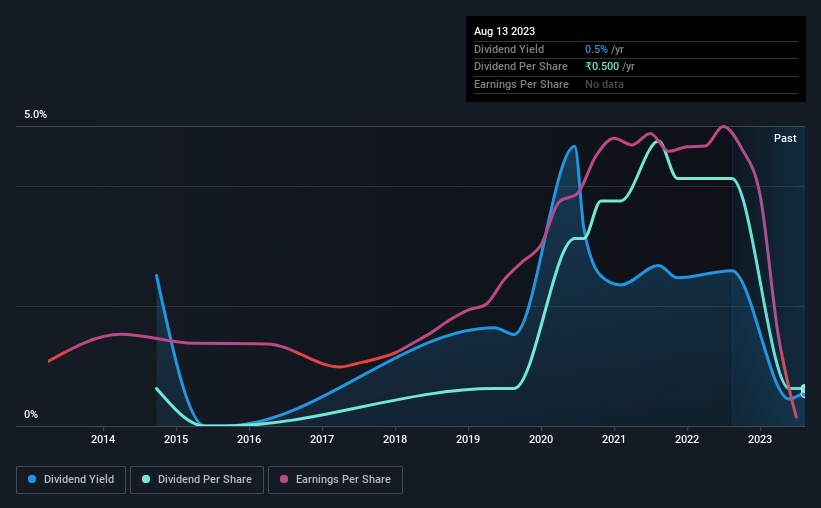Ester Industries' (NSE:ESTER) Shareholders Will Receive A Smaller Dividend Than Last Year
Ester Industries Limited's (NSE:ESTER) dividend is being reduced from last year's payment covering the same period to ₹0.50 on the 25th of October. This means that the dividend yield is 0.5%, which is a bit low when comparing to other companies in the industry.
See our latest analysis for Ester Industries
Ester Industries' Distributions May Be Difficult To Sustain
It would be nice for the yield to be higher, but we should also check if higher levels of dividend payment would be sustainable. Prior to this announcement, Ester Industries' earnings easily covered the dividend, but free cash flows were negative. We think that cash flows should take priority over earnings, so this is definitely a worry for the dividend going forward.
Over the next year, EPS could expand by 12.5% if recent trends continue. While it is good to see income moving in the right direction, it still looks like the company won't achieve profitability. Unless this can be done in short order, the dividend might be difficult to sustain.

Ester Industries' Dividend Has Lacked Consistency
Even in its relatively short history, the company has reduced the dividend at least once. This makes us cautious about the consistency of the dividend over a full economic cycle. The most recent annual payment of ₹0.50 is about the same as the annual payment 9 years ago. The dividend has seen some fluctuations in the past, so even though the dividend was raised this year, we should remember that it has been cut in the past.
The Dividend Looks Likely To Grow
Growing earnings per share could be a mitigating factor when considering the past fluctuations in the dividend. It's encouraging to see that Ester Industries has been growing its earnings per share at 13% a year over the past five years. A low payout ratio and decent growth suggests that the company is reinvesting well, and it also has plenty of room to increase the dividend over time.
Our Thoughts On Ester Industries' Dividend
In summary, dividends being cut isn't ideal, however it can bring the payment into a more sustainable range. With cash flows lacking, it is difficult to see how the company can sustain a dividend payment. We would be a touch cautious of relying on this stock primarily for the dividend income.
It's important to note that companies having a consistent dividend policy will generate greater investor confidence than those having an erratic one. However, there are other things to consider for investors when analysing stock performance. For example, we've identified 3 warning signs for Ester Industries (1 is a bit unpleasant!) that you should be aware of before investing. Looking for more high-yielding dividend ideas? Try our collection of strong dividend payers.
Valuation is complex, but we're here to simplify it.
Discover if Ester Industries might be undervalued or overvalued with our detailed analysis, featuring fair value estimates, potential risks, dividends, insider trades, and its financial condition.
Access Free AnalysisHave feedback on this article? Concerned about the content? Get in touch with us directly. Alternatively, email editorial-team (at) simplywallst.com.
This article by Simply Wall St is general in nature. We provide commentary based on historical data and analyst forecasts only using an unbiased methodology and our articles are not intended to be financial advice. It does not constitute a recommendation to buy or sell any stock, and does not take account of your objectives, or your financial situation. We aim to bring you long-term focused analysis driven by fundamental data. Note that our analysis may not factor in the latest price-sensitive company announcements or qualitative material. Simply Wall St has no position in any stocks mentioned.
About NSEI:ESTER
Ester Industries
Engages in the manufacture and sale of polyester films in India and internationally.
Second-rate dividend payer with low risk.
Similar Companies
Market Insights
Community Narratives



